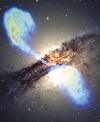Dr. Anna D. Kapinska
- Position
- Alumnus
- Institution
- ICG, University of Portsmouth
- Webpage
- http://www.astro.soton.ac.uk/~a.d.kapinska
- Telephone
- 0044 (0) 23 9284 5167
- Contact
- Complete this online contact form to contact Anna.
Research interests. My current research interests are focused on population studies of radio galaxies and radio-loud quasars in the cosmological context. The unique information on the underlying physical properties of these sources, such as their kinetic luminosities and environments in which they reside, can be derived by means of numerical simulations. My Ph.D. project, which I am completed in 2012, required a solid knowledge of active galactic nuclei (AGNs) and their central engines, relativistic jet physics, radio jet interaction with intergalactic and intracluster medium, expansion history of the Universe and structure formation, and shortcomings of extragalactic surveys in order to avoid any biases in the population study.
Key words: compact objects – X-ray binaries – radio galaxies – radio-loud quasars – relativistic jets – radio structure of AGN – galaxy clusters – source populations – numerical methods – computational modelling – observational radio astronomy
Find more here: http://www.astro.soton.ac.uk/~a.d.kapinska/
and http://research.icg.port.ac.uk/~kapinska/
Projects
Gallery

Composite of radio and optical images of Centaurus A, one of the closest to us powerful radio galaxies. The powerful jets expel energy from the vicinity of the central supermassive black hole. From such radio observations, and developed theoretical models of radio galaxy growth, we are able to extract information on the physical properties of the central engine.
Credits: Sterne & Welraum 2008.

Radio and X-ray emission is often correlated; the X-ray emission may be produced by high energy particles accerelated at the jet shock front where the radio lobe collides with surrounding medium. Thanks to this we can obtain observational contraints on the source environmets to verify the theoretical modelling. The image shows X-ray emission (red) and radio emission from the expanding radio lobe (blue).
Credits: Chandra X-ray Obseratory, Croston et al. 2010.
